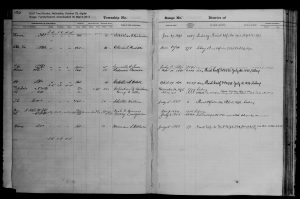
BLM Tract Books for the State of Nebraska, Volume 29.
FamilySearch has digitized cancelled homestead files for selected land offices in Kansas and Nebraska (“United States, Cancelled, Relinquished, or Rejected Land Entry Case Files, 1861-1932“).
These cancelled files contain all the homestead paperwork that had been submitted as of the date of cancellation. This should include the filing of the initial claim. Additional paperwork in the cancelled file will vary depending upon how actively the homestead claimant pursued their claim, whether they had to document citizenship, whether the claim was relinquished voluntarily, if the claim was contested, etc.
The cancelled claims are organized by file numbers assigned to them by the land office. Those numbers appear to have been assigned in the order in which the claims were cancelled. There is no index–well at least not directly.
Finding these cancelled claims requires a use of the Bureau of Land Management’s tract books. These books are organized by land office or by state (depending upon the period and the location) and require the knowledge of where the claim was located as the tract books organize their entries based upon the specific legal description of the land (township, section, quarter section, etc.)
That is not always known in cancelled homestead claims because the claimant never had any actual title to the real property. Title to the real property is granted when the homestead application is approved and the patent is issued. Because the claimant never owned the land they
- will not appear as the land owner in plat books (which may be indexed),
- will not appear in the local land records as a grantee or a grantor.
Plat books and local land records are the most common ways to determine where a homestead was located so that the tract books can be searched. Plat books make it clear where the property was located and land records will contain a legal description of the property.
If the tract books are organized geographically and not alphabetically and I don’t know where the property is, how should these records be searched?
The tract books keep track of all claims that have been filed on a piece of property in the federal domain–even claims that were cancelled. The entry for that cancelled claim in the tract book should contain a file number for the documentation regarding the cancelled claim. Because the BLM tract books are unindexed, searching for them requires the researcher to search for those locations in the tract books where the person may have established a claim. The cancelled claim may have been filed in a location where a person lived for several years or only a few months.
Manually searching an entire township is not a formidable task–most are under twenty pages. Searching an entire county obviously takes longer and adjacent county searches may be warranted, depending upon where in a given county a relative is likely to have established a homestead.
Knowing townships to search can be the problem. Keep in mind that people tended to settle in groups and that others in the group may have completed their homestead claims. Completed homestead claims generated patents, which in turn means that others in your ancestor’s group may appear in completed homestead claims, platbooks and local land records. Your person of interest may also appear in a federal or other census which would also give at least the township of residence.
The cancelled claim for Mary Duignan was in section 35 of township 18N 44W. It was cancelled as shown in the illustration.


There is a notation that the claim was actually relinquished at the North Platte land office with a preceding file number of 01741. That’s the number to locate the cancelled homestead file. Those cancelled files are organized by land office and then by file number.
Mary’s claim was used solely as an illustration. The digitized files currently on FamilySearch start in 1907 and my “people of interest” had all either filed claims or moved on from Nebraska or Kansas by then.
We will show some sample files in an upcoming post.
More on the BLM tract books can be seen in our Genealogy Search Tip of the Day post.
Details on my BLM tract book webinar can be found here.

No responses yet